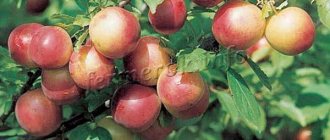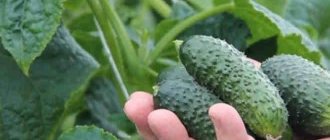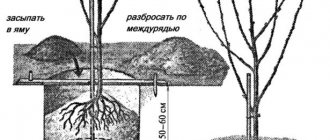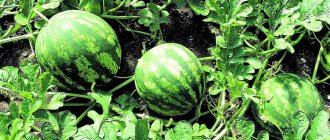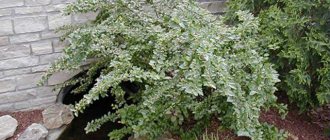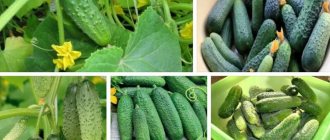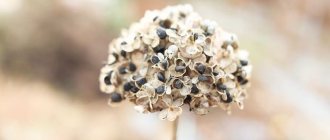Advantages and disadvantages of growing cucumbers in a barrel
Growing cucumbers in barrels certainly has a number of advantages over a regular garden bed. First of all, this is a significant space saving. “Vertical” beds allow you to intelligently organize space even in the smallest garden plot, where every square meter is worth its weight in gold.
When growing cucumbers at home in a barrel, several disadvantages of this planting method can be noted, but even they are easily compensated by a large number of advantages. Here are a few of them:
- one barrel allows you to grow two or three bushes at the same time, even if different varieties were planted;
- a two hundred liter barrel can replace an area of up to two square meters;
- the container can be located in any place preferred for the vegetable crop, where it will receive the required amount of sunlight;
- Feeding with this growing method is used more economically;
- a cucumber bush planted in a container with soil is less susceptible to infectious diseases and insect pests;
- a small planting area significantly reduces the time spent working with soil (loosening, weeding);
- a fruit-bearing bush in a barrel visually gives the garden area a decorative and well-groomed appearance;
- the main advantage of planting this vegetable crop in a container is the absence of weeds;
- watering vegetables is much faster and more convenient;
- when ripe, cucumbers often begin to droop, thereby becoming contaminated by wet soil, and when planted in a barrel, the fruits always remain clean;
- when unexpected frosts occur, compared to a greenhouse, it is easier to insulate the container;
- You can start planting cucumbers in a barrel a few weeks earlier, but in the case of open beds, you must strictly adhere to the deadlines.
It is impossible not to note the disadvantages of this growing method:
- limited space contributes to the rapid drying of the soil, therefore, the gardener is required to regularly monitor the level of humidity and, if necessary, water the plant;
- since most garden containers are made of metal, when exposed to sunlight they heat up quite quickly, so on hot summer days it is necessary to water a little more often than is required for normal planting in open beds;
- if the gardener does not have a free container at his disposal, there is a need to purchase one, and this is an additional expense;
- The preparatory stage of planting cucumbers in a barrel involves the preparation of a substrate - a nutrient medium for the plant - to fill the entire container.
Barrel frame
In the first stages of growth, plants will need reliable supports; they can be replaced with a dome-shaped frame made of wire.
An alternative to the frame is to wrap the barrel in durable burlap, which will serve as a support for the weaving plants and help maintain their integrity.
Barrel selection and preparation
The most important stage when deciding to plant cucumbers in this way is carefully completed preparatory work with the container. Depending on your financial capabilities, you can get a barrel made of plastic or metal.
After the container has been selected, it is necessary to make several medium-sized holes in its bottom so that excess liquid can drain and not stagnate.
Filling the container completely with fertile soil is a grave mistake.
In order for the plant to begin to bear fruit, it is recommended to follow a special “recipe” for filling a barrel for cucumbers:
- First of all, strengthen the bottom. To do this, fill 1/3 of the container with tops, compost or other food waste.
- The next layer is any organic fertilizer, for example, manure. Having decomposed, it gives off a large amount of heat to the root system of vegetable crops, thereby stimulating their rapid growth.
- The final layer should be fertile and previously loosened soil. There is no need to fill the container to the brim. It is advisable to even leave 7 cm of free space. In the future, this will make it possible to cover the cucumber bushes with cling film in order to protect the young plant from the adverse effects of cold wind.
Find out what the barrel should be like, the soil, whether it needs to be covered and topped up with soil in the following article:
Diseases and pests
It is pointless to expect a good harvest from plants that are sick or suffering from pests. Pests and diseases need to be controlled when the first signs appear. How to recognize them?
Diseases
Powdery mildew. The leaves are covered with a white powdery coating, sometimes with a reddish tint. It spreads quickly. The leaves are drying up and there are fewer and fewer green plants. The disease is caused by a fungus and appears in cold, damp weather. Overfeeding cucumbers with nitrogen and unbalanced watering contribute to this.
A solution of “Topaz”, “HOM”, colloidal sulfur, spraying with sour milk diluted with water in a 1:1 ratio will help. Prevention will also be required - watering only with warm water, temporary shelter during cold weather.
Peronosporosis , otherwise called downy mildew. The disease begins with small light yellow spots on the leaf plate. Their area increases, the leaf dries out completely. This is a fungal disease that can affect even very young plants if the weather is humid or they are watered with cold water. It is also facilitated by a large difference in night and day temperatures.
A warm solution of “Polycarbacin”, “Copper Oxide”, “Ridomil”, “Ordana” will help. To prevent the disease from appearing, spray the plants with whey.
Olive spot , otherwise cladosporiosis. It greatly reduces the marketability of fruits - they become covered with sores and quickly rot. Dark spots are also noticeable on the leaves. This is the work of the fungus. The reason is dampness and cold. The source of infection is the tops of diseased plants.
Fundazol and copper-containing drugs help. It is advisable not to water the plants for 4-5 days.
White rot or sclerotinia. A white fluffy coating appears on all parts of the plant, which darkens over time. High humidity promotes the spread of fungus.
Trimming the damaged parts to healthy tissue with mandatory treatment with crushed coal or lime will help.
Anthracnose . Reddish-brown spots quickly occupy the entire area of the leaf, and it dries out. The reason is a fungus that rages in damp, cool weather.
Treatment with copper-containing preparations helps.
Root rot . If your cucumbers' development is slow and the leaves are drying out, it's time to check them for root rot. In diseased plants, the roots turn black and die. It is necessary to stimulate their regrowth by adding a layer of fertile soil 5 cm high. Completely dried plants are removed.
Soil preparation
It is worth paying special attention to soil preparation, since good soil is the key to a high yield. As mentioned earlier, the soil should be fertile and light in texture.
For planting in a container, pre-cleaned soil from a garden plot will also work. It is mixed with compost and sifted several times in order to remove any accidentally caught larvae of harmful insects. A strong solution of potassium permanganate or phytosporin is used as an antiseptic.
Seed preparation
Preparatory work with cucumber seeds takes place in several simple steps:
- Selection of suitable seeds. To complete this step, soak cucumber seeds in warm water for 6-7 minutes. Then take them out and place them in a saline solution (proportions: 6 g of table salt per 1 liter of liquid). Remove any seeds that float to the top and discard. They will not sprout when planted. Rinse the seeds that remain at the bottom thoroughly in plain water and dry.
- Hardening. The most popular and affordable way to harden cucumber seeds is to place them in a damp piece of cloth and place them on one of the refrigerator shelves. They should stay like this for 72 hours. Then remove the seeds and leave to thaw for 9-10 hours.
- Disinfection. This procedure is necessary to protect seedlings from harmful insects and various infectious diseases. Place the seeds for a few minutes in a pre-prepared solution of a mixture of potassium permanganate (1%) and acetic acid (1%). After which the seeds are thoroughly washed again in water at room temperature.
- Soak. The final stage of preparing cucumber seeds is to place them in a damp piece of cloth until they are completely swollen. As a rule, the time spent soaking seeds does not exceed 24 hours.
- Treatment with a growth stimulating agent. The stimulant can be purchased at any specialized garden store. However, experienced gardeners recommend using the following recipe. For 5 tsp. wood ash take 800 g of water. The resulting mixture is thoroughly mixed and the treated cucumber seeds are poured. Wood ash has a lot of nutrients and beneficial microelements, which not only contribute to the rapid growth of vegetable crops, but also strengthen its protective properties from harmful external influences. After 2 hours, the nutrient liquid is removed. The seeds are ready for planting.
Many inexperienced gardeners are of the opinion that the more stimulating solutions, the better the seeds will sprout. However, this is a misconception. The fact is that a cucumber seed has a protective shell, which under no circumstances should be destroyed, otherwise it will die before it is planted in the ground.
Repeated stimulation using various chemicals only contributes to the destruction of the protective shell, but not to the growth or development of the seedling.
Selecting a location
Cucumbers need good lighting for rapid growth and development. The plant is heat-loving, so the choice of location should be on the sunny side.
If the container is made of metal, then on hot summer days the container will overheat greatly. This nuance is also worth taking into account.
A metal container can be protected from overheating on a clear sunny day. In order not to damage the cucumber stems from the sun's rays, it is recommended to wrap the barrel with industrial film or lutrasil. Thanks to this simple method, you can not only protect the plant from possible sunburn, but also give the old container a more decorative look.
For growing cucumbers in a barrel, the ideal area is slightly darkened and protected from wind or draft. Do not forget that the gardener must have constant access to the container from each side.
Which varieties are best to choose and how many plants to plant?
The procedure for growing cucumbers in a barrel has a number of stages; after filling the barrel with soil, you need to choose the best variety of crop.
Experienced gardeners recommend giving preference to hybrids that have already been tested by time, are characterized by cold resistance and increased productivity.
You can place no more than 6 bushes in one barrel, planting seeds or pre-grown seedlings around the circumference.
The number of plants is calculated based on the diameter of the base of the barrel and its displacement. Large plastic containers will help replace such a container, but it is better to choose metal objects.
Planting cucumbers in a barrel: step-by-step process
The process of planting cucumbers in a barrel is quite simple to perform and even a novice gardener who does not have much experience working with vegetable crops can do it.
It is only advisable to strictly adhere to the algorithm of actions presented below, and then the plant will definitely bear tasty and juicy fruits:
- A few days before planting a vegetable crop, water the soil thoroughly so that it subsides a little.
- Add fertile soil on top to replenish the previous level.
- Carefully loosen the soil and make small holes, the depth of which will not exceed 3 cm.
- Distribute the seeds so that the cucumber bushes are at the same distance from each other.
- It is recommended to plant seeds “with a reserve”, since there is always a possibility that some seed will not sprout. The excess bush can always be transplanted to a garden bed or another container.
- Then each hole is sprinkled with humus from plant or animal remains.
- Water the holes exclusively with warm, settled water. It is best to water using a watering can with a small sieve.
- The final stage of planting is covering the container with cling film to create a greenhouse effect. To prevent the cling film from slipping, it is recommended to secure it with an elastic band or twine.
Which cucumbers are suitable for barrel growing?
There are no special varieties for this purpose; you can easily sow your favorite cucumbers. These can be early ripening hybrids, for example, Muromsky or Othello. Thanks to the decomposing plant layer at the bottom, the barrel will warm the soil and speed up ripening. And in warm soil, bushes are not afraid of return frosts, and on top they can be hidden under a film.
It is no less profitable to grow late-ripening varieties in this way, all for the same reasons. A warm barrel will further prolong the fruiting of Phoenix and other late varieties.
Plant no more than 5 plants in one barrel, space is limited. Place the seeds in the holes several at a time, with a margin, leaving 15 cm between them.
Features of care
Regardless of the chosen method of growing cucumbers, this vegetable crop needs the constant attention of the gardener. If you want to get a healthy fruit-bearing plant, you will need to put in some effort to care for it.
Watering and fertilizing
Watering vegetables is done only after the soil has dried, no more than twice every 7 days. Experienced gardeners suggest using self-made drip irrigation. This is a device that is a regular plastic bottle. And its volume is designed for 3 liters of liquid.
Before placing it in a container, small holes are made on the bottle using a preheated sewing needle or awl. Then the bottle with holes is placed in the barrel, so that the neck is strictly in the center. Next, the entire surface of the bottle is sprinkled with earth. Each time you add water, the liquid will gradually drain and moisturize the root system of the cucumbers.
For this particular growing method, it is recommended to use a concentrated organic fertilizer called liquid vermicompost. This solution must be diluted with water in a ratio of 1:3. For one cucumber bush, use 250 ml of the drug, no more.
It has been noted that timely fertilizing promotes abundant fruiting and strong plant immunity. Feeding is carried out only two weeks after the cling film has been removed from the surface of the barrel. Superphosphate (no more than 20 g) and potassium sulfate (no more than 10 g) are most often used as mineral fertilizers.
For details on caring for cucumbers in a barrel, see this article:
Formation and garter of bushes
Cucumbers grown in containers must be tied up to form bushes. This will not only make harvesting easier in the future, but will also allow the plant to breathe, and will also protect against infectious diseases and insect pests transmitted through open ground.
The most popular and accessible method of tying cucumber bushes to a barrel is a meter-long wooden (or metal) stick installed in the middle of the container. A cross is fixed on top of this stick, to which the garden twine is fixed.
When the bush grows, the lashes will begin to wrap around the stick, gradually moving onto the cross, forming a kind of “umbrella”. This design is not only convenient to care for the plant, but also looks extremely elegant. It is recommended to tie it only after the plant has more than 5 leaves.
Why do the leaves turn yellow?
There may be several reasons for yellowing leaves on cucumber bushes:
- Lack of timely watering. Insufficient soil moisture leads to dehydration of the vegetable crop, and it begins to wither.
- Lack of fertilizer. During the growing season, cucumber bushes are in dire need of nitrogen fertilizing. The appearance of the first signs of yellowness may indicate that the plant needs to be fed.
- Low temperatures provoke stress in heat-loving cucumbers.
- Yellow spots may be sunburn. The cucumber bush is watered at the root without affecting the leaves. Therefore, it is advisable to water cucumbers only in the morning or evening.
- The presence of an infectious or viral disease. The most famous is fusarium. The affected leaves quickly acquire a yellow tint and start the process of withering of the entire plant.
- Violation of the integrity of the plant roots. If harmful insects have reached the root system, or it has been damaged during weeding, the leaves acquire yellowish spots.
Little ovary
Barren flowers are a fairly common problem when growing cucumbers. This happens when planting fresh seeds. Seedlings first produce a male flower - a barren flower, and only then - a female flower (ovary). To prevent this from happening, it is recommended to plant seeds that are three years old, from which the ovaries appear before the barren flowers.
Another common cause is improper use of fertilizers. An excess of nitrogen fertilizing has a detrimental effect on vegetable crops, causing an active increase in barren flowers and canes. A quick-acting phosphorus solution mixed with water (in a ratio of 1:10) or ordinary wood ash mixed into the soil of the plant will help correct the situation.
Diseases and pests
Cucumbers in a barrel are also susceptible to various diseases and pest attacks. The most common disease of cucumbers is fusarium. The danger is that the plant does not show any symptoms for several days and the disease can only be detected after the entire cucumber bush has been infected.
It is possible to defeat fusarium; you just need to carry out a series of simple steps. First of all, soil disinfection is necessary. This can be done by adding fungicidal agents to the soil, available at any gardening store.
In order to increase the resistance of a vegetable crop to fusarium, it is recommended to resort to the help of a growth stimulator. The most famous is called “Gumisol”. It is equally effective both when treating seeds before planting and as a spraying agent during the growing season of a vegetable crop.
There are a considerable number of insects who want to feast on the juicy cucumber foliage - aphids, spider mites, wireworms, whiteflies, etc. Their size is miniature, but the scale of destruction is enormous.
Over the years, gardeners have learned to effectively combat insect pests by spraying the foliage of cucumber bushes. Garlic tincture is especially popular among insect repellent liquids. You can prepare it yourself at home. To do this you will need to acquire:
- 2 liters of water;
- 400 g chopped garlic cloves.
The ingredients are thoroughly mixed and left to infuse for five days. After time, the resulting solution is further diluted with two buckets of water. This tincture is sprayed over the entire surface of the cucumber bushes using a spray bottle.
Harvesting
Harvesting cucumbers grown in a barrel is quite an enjoyable process. Since there is no need to constantly bend over to the beds and collect fruits that are sometimes heavily contaminated with soil.
With this growing method, it is much easier and more convenient to detect ripe cucumbers, as well as to collect them. There is access to the bushes from any side, unlike plants planted in a conventional greenhouse. Harvesting is permissible both during the day and in the evening.
Cucumbers can be removed manually by picking them with your hands. However, experienced gardeners are of the opinion that it is preferable to use garden shears. This way there is no damage to the lashes or ovaries.
When picking cucumbers, it is advisable to carefully inspect the bushes. If any deformation of the sheets or signs of an infectious disease are detected, the damaged area must be removed immediately. This will protect the neighboring bush.
According to a large number of positive responses from gardeners and summer residents regarding growing cucumbers in a barrel, this method really allows not only to significantly save space in the garden plot or vegetable garden, but also to facilitate the process of caring for this vegetable crop.
Caring for cucumbers after planting
As soon as you remove the covering, the cucumbers will grow rapidly, so do not forget to tie them to a support. Caring for cucumbers growing in a barrel is minimal: you need to loosen the soil between the bushes and from time to time add mullein or nettle infusion to the soil. Water the cucumbers only with warm, settled water 1-2 times a week, and do not forget to fill the buried bottles with the same water: an improvised drip irrigation system will reliably protect the soil and cucumbers from drying out. You won't have to pinch the vines or fight weeds.
Reviews from gardeners
★★★★★
Natalya, 47 years old, economist, Nizhny Novgorod region. For a long time I couldn’t get a good harvest of cucumbers because of the endlessly appearing slugs.
They literally ate all the roots of the bushes. The next year I planted cucumbers in old barrels near the fence. The harvest was plentiful, and the bushes were lush and strong. This is the only way I grow cucumbers now. ★★★★★
Yulia, 36 years old, salesperson, Yoshkar-Ola. I became interested in this method of planting after I saw how easy it was for my neighbor to care for cucumber bushes.
You don’t need to stand for several minutes to weed one bed. And watering is quick and convenient. ★★★★★
Sergey, 54 years old, driver, Maly Puyal. A convenient and original method of growing cucumbers.
I placed containers with bushes along the fence on the sunny side. The foliage stretches up the fence - it looks very impressive. Collecting fruits is also a pleasure. The only thing I noticed is that it is necessary to periodically turn the containers over so that the lashes do not fade from the sun’s rays. Hide
Add your review
It is quite simple to obtain a bountiful and tasty harvest using this method of growing cucumbers. The first harvest from a barrel occurs several weeks earlier than in open beds, since the microclimate in the first case is more favorable for vegetable crops. Carefully planted cucumber bushes in barrels visually give the garden area a more decorative and well-groomed appearance.
0
0
Copy link
How to pick cucumbers correctly
Picking cucumbers is the most enjoyable moment in the entire growing process. The fruits are easy to pick, since there is no need to bend over; cucumbers are clearly visible from any side. Experienced gardeners advise adhering to some rules for harvesting vegetables:
- Cucumbers need to be collected daily or every other day. This harvesting method allows new fruits to form;
- It is better to remove the vegetable using scissors in order not to harm the ovaries and lashes;
- Deformed fruits, as well as those with spots, should definitely be thrown away so as not to infect nearby growing vegetables;
- Harvesting is best done in the morning or evening. There is no intense heat at this time.


